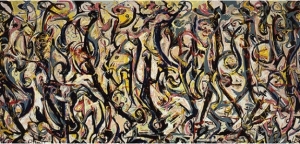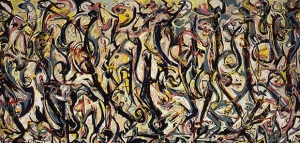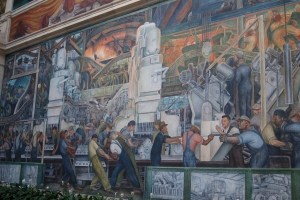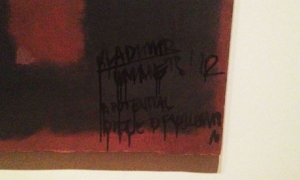|
Displaying items by tag: mural
This exhibition celebrates the gift of Thomas Hart Benton's epic mural America Today from AXA Equitable Life Insurance Company to The Metropolitan Museum of Art in December 2012. Benton (1889–1975) painted this mural for New York's New School for Social Research to adorn the school's boardroom in its International Style modernist building on West 12th Street. Showing a sweeping panorama of American life throughout the 1920s, America Today ranks among Benton's most renowned works and is one of the most remarkable accomplishments in American art of the period.
The ten-panel mural will be featured in a space that recreates the boardroom in which it originally hung.
Iowans have welcomed home an art favorite.
Jackson Pollock’s Mural, which underwent nearly two years of conservation work, has returned to Iowa. This past weekend, the Sioux City Art Center held an opening for the exhibit.
The display will remain at the art center until April 2015.
“This painting by Jackson Pollock is the most important work of art in Iowa and one of the most significant paintings in American art,” said Sean OHarrow, the director of the University of Iowa Museum of Art.
Initially scheduled to start on June 10, the now nine-month display is part of Museum of Art’s sharing project called “Legacies for Iowa.” Museums, art centers, and galleries are provided pieces from the UI’s 14,000-part collection as part of the program.
Sandra and Bram Dijkstra have given the Huntington its first two paintings by African-Americans: Charles White’s Soldier (1944) and Robert Duncanson’s Landscape with Ruin (c. 1853). This is a coup for the Huntington as the paintings had been on loan to the San Diego Museum of Art. Bram Dijkstra is an art historian who long taught at UC San Diego.
Chicago-born Charles White lived in L.A. for most of his career. Soldier is a relatively early work, made about when the artist was drafted at age 26. It was made the year after White’s most famous work, the Hampton University mural of The Contribution of the Negro to Democracy in America.
Earlier this year, the Institute of Contemporary Art got disappointing news: It would no longer be in charge of painting the massive Dewey Square wall mural, at the head of the Rose Fitzgerald Kennedy Greenway. The job would instead go to the more mainstream Museum of Fine Arts.
Jill Medvedow, ICA director, was not pleased. “Really?” she said. “It’s walking distance to the ICA.”
Other Greenway changes, perhaps more universally welcomed, are in the works. On Wednesday the nonprofit funder ArtPlace will announce a $250,000 public art grant for the Greenway, a 15-acre network of parks in downtown Boston. That follows by just a few days the announcement of plans for a $1 million public art expansion that will include the installation next year of a huge, billowing fabric work meant to hover over the park, by Brookline-based artist Janet Echelman. The Greenway is even hiring its own art curator.
The iconic Rose Main Reading Room at the New York Public Library‘s 103-year-old 42nd Street flagship will remain closed for six months after a plaster rosette fell from the ceiling last month, according to a press release.
The nearly two-block-long room, which sees an average of 2.3 million visitors each year, boasts gorgeous 52-foot tall ceilings adorned with intricate plaster detailing and murals of billowing pink clouds. The space was last restored in 1998, thanks to a $15 million gift from the Rose family, whom the room is now named after.

The J. Paul Getty Museum in Los Angeles announced that its exhibition dedicated to Jackson Pollock’s recently restored “Mural,” has given the museum a welcome boost in attendance. In March, 127,466 patrons visited the Getty, an increase of 3% from the same month in 2013. Last year, the museum also saw an unusually high attendance rate due to an exhibition of Johannes Vermeer’s “Woman in Blue,” which was on loan from the Rijksmuseum in Amsterdam. From 2010 to 2012, average March attendance at the Getty hovered around 97,000.
“Mural," a stunning oil-on-canvas measuring more than 8 feet tall and nearly 20 feet long, recently underwent a year-long restoration at the Getty. Conservators removed a layer of varnish from “Mural,” which now appears much brighter and closer to its original appearance. The work, which was painted in 1943 for the well-known art collector Peggy Guggenheim, represents a turning point in Pollock’s career in which he gravitated towards the abstract expressionist characteristics that define his seminal “drip” paintings. The work belongs to the University of Iowa Museum of Art, which received it as a gift from Guggenheim in 1951.
The Pollock show opened at the Getty on March 11 and details the conservation of the painting. During the first week of the exhibition, the Getty welcomed 29,374 visitors, a 25% increase from the first week of the month. The last week of March saw a 46% jump from the first week of the month.
"Mural" will remain on view at the Getty through June 1.

Jackson Pollock’s “Mural,” a stunning oil-on-canvas measuring more than 8 feet tall and nearly 20 feet long, is currently on display at the J. Paul Getty Museum in Los Angeles. The painting recently underwent an extensive restoration at the Getty Center, which took over a year to complete.
“Mural,” which was painted in 1943 for the well-known art collector, Peggy Guggenheim, represents a turning point in Pollock’s career in which he gravitated towards the abstract expressionism that defined his seminal “drip” paintings. The work belongs to the University of Iowa Museum of Art, which received it as a gift from Guggenheim in 1951.
Restorers removed a varnish that was added to the painting during a 1973 restoration. While the previous conservation effort helped preserve the work, the varnish significantly darkened the painting’s colors. “Mural” now appears much brighter and its colors are closer to their original intensity.
During the restoration process, conservators made a number of new discoveries regarding the Pollock painting. It had long been believed that the artist created “Mural” in a single creative burst that lasted between 24 and 36 hours. Restorers noticed that Pollock’s initial paint marks, which cover the entire canvas, were made in four highly diluted colors, which could have been created in a day. However, the other additions to the canvas would have taken much longer than that to dry. Restorers also confirmed that Pollock used house paint as well as high-quality oil paints to make “Mural.”
“Mural” will remain on view at the J. Paul Getty Museum through June 1. After it leaves Los Angeles, the painting will go on view at the Sioux City Art Center in Iowa for several months.

Thanks to a grant from Bank of America’s Art Conservation Project, the Detroit Institute of Arts has embarked on a research endeavor focused on examining and digitally photographing 13 full-scale preparatory drawings by Diego Rivera for his Detroit Industry murals. The drawings have not been viewed since 1986 and have never been photographed. The project, which started on July 22, 2013, will last through August 2, 2013 and will include any necessary conservation work on the drawings.
Rivera gave the drawings, which are housed in a climate-controlled custom storage in the museum, to the DIA after he completed his monumental Detroit Industry murals in 1933. The series of frescoes, which features 27 panels surrounding the museum’s Rivera Court, depict the then state-of-the-art Ford Motor Company River Rouge Plant. The murals stirred up controversy following their completion and critics deemed the works blasphemous, vulgar, un-American and Marxist propaganda. While members of the Detroit community called for the destruction of the murals, commissioner Edsel Ford and DIA Director Wilhelm Valentiner defended the murals’ right to exist.
Following the research project, 5 of the 13 panels will be go on view at DIA as part of an exhibition of works by Rivera and his wife Frida Kahlo created during their time in Detroit.

A monumental mural by Ellsworth Kelly (b. 1923), an American painter and sculptor often associated with color field painting and the Minimalist movement has found a temporary home at the Barnes Foundation just outside of Philadelphia.
The Barnes, an educational art institution, is currently hosting the exhibition Sculpture on the Wall, which includes Kelly’s Sculpture for a Large Wall. Created between 1956 and 1957, the work was commissioned for the Philadelphia Transportation Building and it was the first public abstract sculpture in Philadelphia. The work was removed from the Transportation Building after it closed in 1993 and was later acquired by Ronald S. Lauder, the former chairman of the Museum of Modern Art. Lauder and his wife promptly donated the work to MoMA where it has only been exhibited twice.
Sculpture for a Large Wall, which measures over 65 feet long and 11 feet high, is accompanied by four other works from later in Kelly’s career including the geometric Red Curve (1986) and the minimalist Two Curves (2012). The sculptures will be on view at the Barnes Foundation through September 2, 2013.

On October 6, 2012, Vladimir Umanets, entered the Tate Modern in London and defaced the one of the museum’s most treasured paintings, a mural by Mark Rothko (1903-1970). Born Wlodzimierz Umaniec in Poland, 26-year-old Umanets currently lives in England.
Umanets vandalized Rothko’s Black on Maroon (1958) by writing his name in black paint along with “A Potential Piece of Yellowism” in the corner of the canvas. Umanets claimed that his defacement was an artistic act and compared himself to Marcel Duchamp, a pioneer of conceptual art known for his appropriation of objects.
Umanets appeared at Inner London crown court on December 13 and was given two years in jail by Judge Roger Chapple. Umanets had pleaded guilty at a previous hearing.
The Rothko mural was originally intended for the Four Seasons restaurant in New York and was given to the Tate as a gift from the artist in 1969. The Tate has made plans to restore the work, but the process will not be an easy one. Rothko often used unusual materials, such as eggs and glue, making restoration especially difficult. Officials estimate that the project will cost nearly $325,0000 and will take around 20 months to complete.
|
|
|
|
|